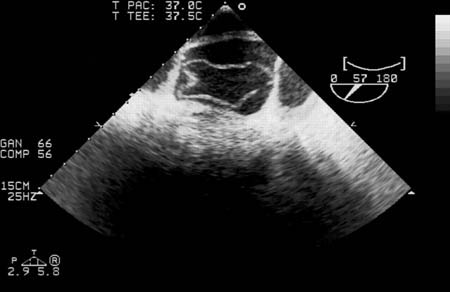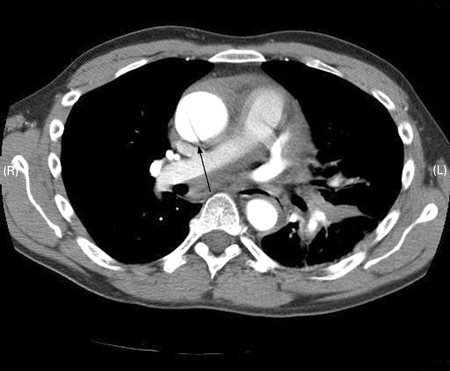Case history
Case history
A 59-year-old man presents to the emergency department with a sudden onset of excruciating chest pain, which he describes as "stabbing". There is a history of hypertension. On physical examination, his heart rate is 95 bpm. Blood pressure is 195/90 mmHg in the right arm and 160/80 mmHg in the left arm. Pulses are absent in the right leg and diminished in the left.
Other presentations
The pain of aortic dissection usually manifests as acute, tearing chest and back pain (Stanford Type A) or tearing back pain (Stanford Type B). It may also migrate through the thorax or abdomen. Although the classic textbook description is of acute tearing or ripping pain, patients more commonly describe the abrupt onset of severe “sharp” or “stabbing” pain, maximal at onset.[4]
Symptoms of stroke or visceral or acute limb ischemia may be present. Patients may be hemodynamically stable or in hypovolemic shock. Occasionally, depressed mental status or neurologic changes, limb pain, paresthesias or weakness, paraplegia, or syncope are presenting symptoms. Infrequently (less than 10%), patients present atypically without pain.[5] There may be signs of heart failure, pericardial tamponade, or a left pleural effusion. Younger patients can present with a recent history of heavy lifting or cocaine use.
Patients with connective-tissue disorders such as Marfan syndrome often present in their 30s, most often due to aortic root enlargement. Patients with Marfan syndrome with a normal diameter aorta may also be at risk.[4][Figure caption and citation for the preceding image starts]: Transesophageal echocardiography (transverse aortic section) showing a circumferential dissection of the ascending aorta in a 30-year-old patient with features of Marfan syndromeBouzas-Mosquera A, Solla-Buceta M, Fojón-Polanco S. Circumferential aortic dissection. BMJ Case Reports 2009; doi:10.1136/bcr.2007.049908 [Citation ends]. [Figure caption and citation for the preceding image starts]: CT scan showing dissecting aneurysm in a 45-year-old patient with Marfan syndrome experiencing chest painSanyal K, Sabanathan K. Chest pain in Marfan syndrome. BMJ Case Reports 2009; doi:10.1136/bcr.07.2008.0431 [Citation ends].
[Figure caption and citation for the preceding image starts]: CT scan showing dissecting aneurysm in a 45-year-old patient with Marfan syndrome experiencing chest painSanyal K, Sabanathan K. Chest pain in Marfan syndrome. BMJ Case Reports 2009; doi:10.1136/bcr.07.2008.0431 [Citation ends].
Use of this content is subject to our disclaimer